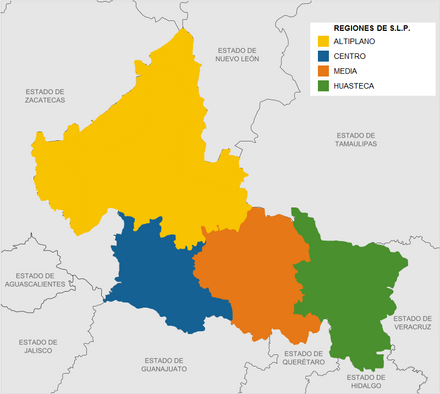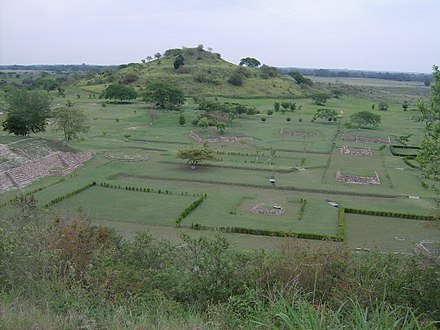San Luis Potosi (state) - state of Mexico
San Luis Potosí is a state in the Bajío, in Central Mexico. The state lies mostly on the Mexican Plateau, with the eastern part descending into the tropical valley of the Tampaon River. The state has relied largely on mining through its history, and its agricultural sector produces large crops of wheat, maize, beans and cotton in the uplands. In the low tropical valleys, sugar, coffee, tobacco, peppers and fruit are staple products. Livestock is also an important industry.
Regions
San Luis Potosí has four distinct regions each with a different climate, culture and history.

This region has a rich mining tradition in gold, silver and zinc. The railroad later brought development and a strong participation in the national politics of Mexico.
Includes the capital city with the Seven Historical Neighborhoods (Siete Barrios) that formed the original city, the historical center with colonial architecture and the commercial and political center of the state.
Río Verde Valley (Region Medio)
A rich agricultural region of mostly rural character.
Coastal plains and the eastern reach of the Sierra Madre with a distinct culture greatly influenced by the Huastec Indians.
Cities
- Central Plateau
- San Luis Potosí 📍 - State capital
- Charcas
- Venado
- Salinas
- Matehuala 📍
- Mexquitic de Carmona
- Real de Catorce 📍
- Cedral
- Ahualulco
- Santa María del Río
- Huasteca Potosina
- Aquismon - One of several towns in the heart of the Huastec, Aquismon is also the stepping off point to Sotano de las Golodrinas and the southern access to Casacada Tamul.
- Ciudad Valles 📍 - Largest city of the region and commercial and cultural center. It lies on the Old Pan-American Highway, the first paved road to traverse Mexico from north to south. Ciudad Valles sits in the wide valley between the first two ridges of the Sierra Madre.
- Ebano - On the eastern coastal plain, this was the area of early oil and gas development.
- Tamazunchale - The largest town in the Nahua region, on the Rio Moctezuma and at the foot of the Sierra Madre.
- Xilitla 📍 - Sir Edward James created the surrealistic Las Pozas here, but it required the ingenuity and work of local residents to carry out. The artistic tradition continues to grow as other artists are attracted to this village.
- Río Verde Valley
- Cerritos
- Cárdenas
- Ciudad del Maíz
- El Refugio
- Rioverde and Ciudad Fernández - The capitals of their respective municipalities, these two towns are separated only by a street and form the largest town in the region.
Other destinations
Archaeological sites
Both of the archeological parks are located near the town of Tamuín, just east of Ciudad Valles.
- El Consuelo - an older site.
- Tamtoc. Its discovery has resulted in a reevaluation of the Huastec culture. A calendar and ball park are part of the discoveries. 2020-12-26
Protected natural areas
Central Plateau
- Wirikuta: the place of pilgrimage for the Huichol (Wirrárika).
- Sierra de la Mojonera
- Real de Guadalcázar: the largest variety of cactus on the American continent.
Capital city
- Ejido San Juan de Guadalupe
- Paseo de la Presa San José
- Parque Nacional El Gogorrón
- Reserva Forestal y de la Fauna Sierra de Álvarez
- Parque Nacional El Potosí extends from Santa María to Río Verde Valley.
Huasteca Potosina
- Reserva de Tancojol
- Reserva Forestal Nacional Porción Boscosa del Estado de San Luis Potosí
- Reserva de la Biosfera Sierra El Abra Tanchipa
Understand
Get in
By plane
Ponciano Arriaga International Airport (Aeropuerto Internacional Pociano Arriaga) (IATA: SLP) is the only airport in the city of San Luis Potosí. It is a really small airport for a medium city. Having only 2 gates and only two international inbound/outbound destinations (Dallas and Houston) and only one daily national destination (Mexico City) and twice weekly service to Monterrey. It is served by Aeromexico, Aerolitoral, American Airlines, and United.
The closest large airport to the eastern part of the state is Tampico. Both have car rentals.
There is a smaller airport in Tamuin just east of Ciudad Valles. Tamuin offers flights to the border and San Luis Potosí.
By car
The major highways are the Old Pan American Highway (85) that runs along the coastal plain and through Ciudad Valles. Another is the Olympic Highway from Laredo to Mexico City which travels the central plateau and passes through San Luis Potosí. Highway 70 runs from San Luis Potosí to Rioverde and the remaining part to Ciudad Valles.
By train
A major railroad runs north-south through San Luis Potosí. Another railroad connects Ciudad Valles to Tampico and to San Luis Potosí in the other direction. These are freight railroads, but a lot of migrants from Central America hitch rides on the train on their journey north to the U.S. If you're adventurous you could join the campesinos.
By bus
There is extensive bus service running both major north-south highways as well as local buses and taxis. You can use Greyhound in the USA to get to San Luis Potosi cheaply, especially if coming from the regions that border Mexico. Bus companies:
- Transpaís (01-800) 713-1000
- Transportes Venecedor (01-800) 640-9354
- Omnibus de México (01-800) 640-9354
- ETN (01-800) 800-0386
- Autobuses del Noreste (01-800) 280-1010
- Flecha Amarilla (01-800) 375-7587
- Grupo Estrella Blanca (01-800) 507-5500
- Grupo Senda (01-800) 890-9090
Get around
Within the state, bus, automobile, and taxis are the primary source of travel. Buses are listed above. Rental Cars (dead link: December 2020) are available only in the city of San Luis Potosí. Taxis are available throughout the state.
See
Museums
- Huasteca Potosina
- Ciudad Valles
- *Museo de las Culturas de la Huasteca Potosina Tamuatzán
- *Museo Regional Huasteco
- Tamuín
- *Museo Universitario Lariab de Historia Antigua de la Huaxteca
- Xilitla
-
- Museo Edward James
Festivals
Central Plateau
- Festival del Desierto del Altiplano Potosino (April - May) Music, dance and theater in towns throughout the Altiplano.
Capital City
- Encuentro Bianual de Decimistas y Versadores de Latinamérica y el Caribe (October) - Open air concerts, recitals, lectures and round tables of genres from Latin America, the Caribbean and Europe.
- Festival de Danzas Étnicas de la Huasteca Potosina (December) - Festival of the ethnic dances of the Huasteca Potosina
- Festival del Son (March) - Promotes the musical form son.
- Festival de Música Antigua y Barroca (November) - Celebration of the founding of the city of San Luis Potosí featuring Medieval, Renaissance, Colonial, Arab, Andalusian and Baroque music.
- Festival de Música Vernácula (March) - Festival of regional and popular music.
- Festival de San Luis (April - May) - Festival of art and culture.
- Festival Internacional Letras en San Luis (May) - Festival of literature.
- Festival Internacional de Danza Contemporánea de San Luis Potosí Lila López (September - October) - Festival of contemporary dance.
- Muestra Anual del Folklor (December) - Exhibition of folk dance.
- Muestra International de Folklore y Artes Tradicionales (September) - Exhibition of folk music and folk dance of Mexico and other countries.
Huasteca Potosina
- Feria Nacional de la Huasteca Potosina (FENAHUAP): March in Ciudad Valles
- Xantolo (Huastec version of Day of the Dead): October
Río Verde Valley
Pame festivals
- Candlemas or Purification of the Virgin Day (February 2)
- Saint Joseph's Day (March 19)
- Holy Week (Semana Santa): Most important celebration
- Holy Cross Day (May 3)
- The Assumption of the Virgin Mary (August 15)
- Day of the Dead (All Souls' Day)
- Christmas
Protected historical areas
The center of the city of San Luis Potosí has been declared a "centro de monumentos históricos." Some of the buildings that have been preserved are the Museo Federico Silva (modern sculpture), the Museo Nacional de la Máscara (National Museum of the Mask), the old Penitenciaría and the Teatro de la Paz (Peace Theatre).
Springs
Central Plateau
- San Juan de Vanegas
Capital City
- El Gogorrón
Huasteca Potosina
There are many springs. Taninul is a warm springs that has been developed into a swimming pool with a resort hotel. There is also a small cave with some climbing routes. Often, the springs are called nacimientos or ojos.
- Nacimiento de Huichihuayan
Río Verde Valley
Laguna de la Media Luna (Lake of the Half Moon) is a clear spring-fed lake. Scuba diving and camping are available. Other springs are
- Ojo Caliente
Caves
Huasteca Potosina
Sótano de los Golondrinas (Pit Cave of the Swallows) is the most well-known cave. The swallows spiral up out of the cave every morning and return every evening. For cavers it is a vertical descent to the floor of the cave. There are many caves in this area including
- Sótano de las Huahuas (or La Hoya de las Huahuas)
- Cuevas de Mantetzulel
- Cuevas Sagradas del Viento y la Fertilidad en Chununtzen I
- Grutas los Sabinos
Río Verde Valley
Grutas de Catedral is the most well-known cave and does not require special equipment. Other caves
- El Ángel
Waterfalls
Huasteca Potosina
Cascada de Tamul is a 100-m (345-foot) waterfall where the Río Gallinas pours over the canyon wall into the Río Santa Maria, forming the Río Tampoan. Travertine forms many waterfalls in this region, including
- Cascadas Minas Viejas
- Cascadas Micos
- Cascada El Meco
- Cascada El Salto
Río Verde Valley
- Cascada La Llovisnosa (The Big Mist Waterfall) is the largest of three waterfalls on the Río Verde. The volcanic rock in this area forms these waterfalls and other interesting formations such as the narrow gorge at Pinihuan.
Nature
Capital city
Valle de los Fantasmas (Valley of the Ghosts) is a rock formation that has a ghostly look under a full moon. It is near the highway from San Luis Potosí to Rioverde.
Huasteca Potosina
Puente de Dios, El Trampolín and Balneario Cascadas de Tamasopo is an area of springs, grottos and waterfalls.
Puente de Dios (Río Tampoan) is a travertine bridge a short distance upstream of the mouth of the Río Tampoan. A short paddle (or swim) on flatwater or raft trip through the canyon allows access to the travertine bridge and the pools that form on top for about half the year.
Do
Many activities are possible at attractions listed under See, such as hiking, caving, rappelling, kayaking, swimming, and tubing.
Eat
The enchiladas potosinas, the meat "Cesina", and "Pipian".
Drink
The capital of San Luis Potosi is awesome for night life. There are great clubs such as Mantra, Play, Roush.
